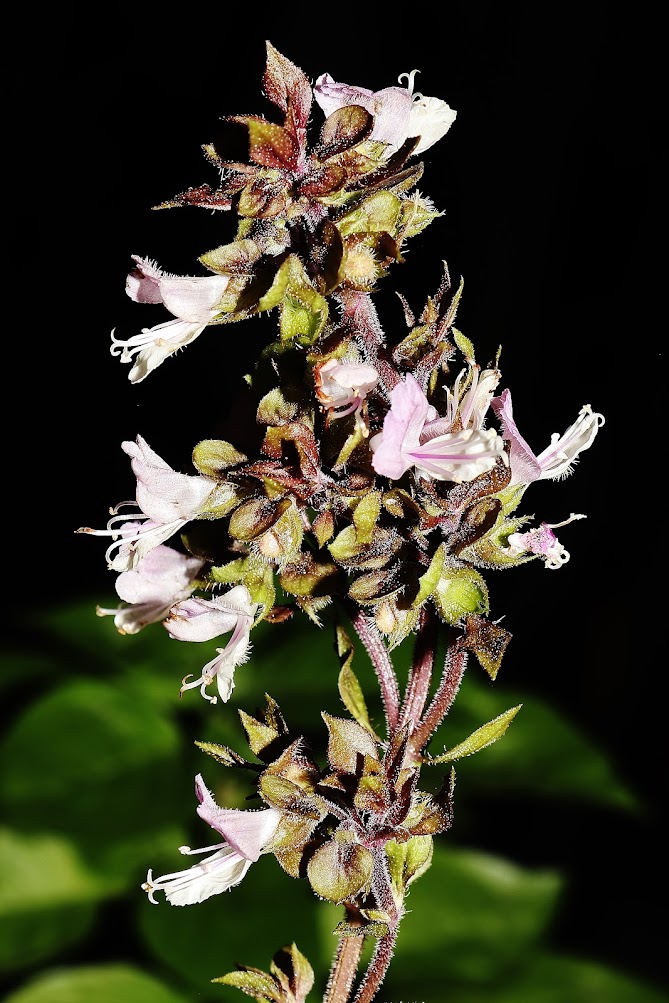Family: Lamiaceae
Basil (/ˈbæzəl/, also US: /ˈbeɪzəl/ Ocimum basilicum /ˈɒsɪməm bəˈzɪlɪkəm/, also called great basil, is a culinary herb of the family Lamiaceae (mints). It is a tender plant, and is used in cuisines worldwide. In Western cuisine, the generic term "basil" refers to the variety also known as sweet basil or Genovese basil. Basil is native to tropical regions from Central Africa to Southeast Asia. In temperate climates basil is treated as an annual plant, however, basil can be grown as a short-lived perennial or biennial in warmer horticultural zones with tropical or Mediterranean climates.
There are many varieties of basil including sweet basil, Thai basil (O. basilicum var. thyrsiflora), and Mrs. Burns' Lemon (O. basilicum var. citriodora). O. basilicum can cross-pollinate with other species of the Ocimum genus, producing hybrids such as lemon basil (O. × citriodorum) and African blue basil (O. × kilimandscharicum).
Etymology
The name "basil" comes from the Latin basilius, and the Greek βασιλικόν φυτόν (basilikón phytón), meaning "royal/kingly plant", possibly because the plant was believed to have been used in production of royal perfumes. Basil is likewise sometimes referred to in French as "l'herbe royale" ('the royal herb'). The Latin name has been confused with basilisk, as it was supposed to be an antidote to the basilisk's venom.
Description Timelapse of growing basil
Desiccated basil showing seed dispersal
Basil is an annual, or sometimes perennial, herb used for its leaves. Depending on the variety, plants can reach heights of between 30 and 150 cm (1 and 5 ft). Its leaves are richly green and ovate, but otherwise come in a wide variety of sizes and shapes depending on cultivar. Leaf sizes range from 3 to 11 cm (1 to 4+1⁄2 in) long, and between 1 and 6 cm (1⁄2 and 2+1⁄2 in) wide. Basil grows a thick, central taproot. Its flowers are small and white, and grow from a central inflorescence, or spike, that emerges from the central stem atop the plant.[citation needed] Unusual among Lamiaceae, the four stamens and the pistil are not pushed under the upper lip of the corolla, but lie over the inferior lip. After entomophilous pollination, the corolla falls off and four round achenes develop inside the bilabiate calyx.
Phytochemistry
The various basils have such distinct scents because the volatile aromatic compounds vary with cultivars. The essential oil from European basil contains high concentrations of linalool and methyl chavicol (estragole), in a ratio of about 3:1. Other constituents include: 1,8-cineole, eugenol, and myrcene, among others. The clove scent of sweet basil is derived from eugenol. The aroma profile of basil includes 1,8-cineole and methyl eugenol. In this species eugenol is synthesised from coniferyl acetate and NADPH. Some of these are useful as insect repellents, see § Insect repellent below.
Distribution and habitat
Basil is native to India and other tropical regions stretching from Africa to South East Asia, but has now become globalized due to human cultivation. From Wikipedia, the free encyclopedia - https://en.wikipedia.org/wiki/Basil
Host plants of a moth - Cabbage looper - Trichoplusia ni (Hübner, 1800–1803) - Cyprus
Ο βασιλικός είναι ετήσιο αρωματικό, ποώδες φυτό, η κοινή ονομασία για το μαγειρικό βότανο Ώκιμον το βασιλικόν της οικογένειας των Χειλανθών Λαμιίδων (δυόσμων) και της τάξης των Σωληνανθών. Σε ορισμένες Αγγλόφωνες χώρες είναι γνωστός και ως «Βότανο του Αγίου Ιωσήφ».
Ο βασιλικός πιθανόν κατάγεται από την Ινδία, ή ίσως από το Ιράν και να έχει καλλιεργηθεί εκεί για περισσότερα από 5.000 χρόνια. Ήταν διεξοδικά αναφερόμενος στους Έλληνες συγγραφείς Θεόφραστο[3] και Διοσκουρίδη. Πρόκειται για ένα ημι-σκληραγωγημένο ετήσιο φυτό, πιο γνωστό ως μαγειρικό βότανο, χαρακτηριστικό κυρίως στην Ιταλική κουζίνα, το οποίο επίσης παίζει σημαντικό ρόλο στις κουζίνες της Νοτιοανατολικής Ασίας της Ινδονησίας, Ταϊλάνδης, Μαλαισίας, Βιετνάμ, Καμπότζης, Λάος και της Ταϊβάν. Αναλόγως με το είδος και την ποικιλία, τα φύλλα μπορούν να έχουν γεύση παρόμοια με το γλυκάνισο, με έντονη, πικάντικη, συχνά γλυκιά, μυρωδιά.
Υπάρχουν πολλές ποικιλίες των Ocimum basilicum καθώς και διάφορα συναφή είδη ή υβρίδια, τα οποία επίσης φέρονται με τη γενική ονομασία "βασιλικός". Ο τύπος, ο οποίος χρησιμοποιείται στα ιταλικά φαγητά, συνήθως, ονομάζεται γλυκός βασιλικός, σε αντίθεση με τον βασιλικό της Ταϊλάνδης (O. basilicum ποικ. thyrsiflora), τον βασιλικό λεμόνι (lemon basil - O. X citriodorum) και τον ιερό βασιλικό (holy basil - Ocimum tenuiflorum), οι οποίοι χρησιμοποιούνται στην Ασία. Ενώ οι πιο διαδεδομένες ποικιλίες του βασιλικού αντιμετωπίζονται ως μονοετή (annual), κάποιοι, σε ζεστά τροπικά κλίματα, είναι πολυετή (perennial),[Σημ. 2] συμπεριλαμβανομένου του «ιερού βασιλικού» («holy basil») και μια ποικιλία γνωστή ως «Αφρικανικός μπλε βασιλικός» («African Blue»).Από τη Βικιπαίδεια, την ελεύθερη εγκυκλοπαίδεια - https://el.wikipedia.org/wiki/%CE%92%CE%B1%CF%83%CE%B9%CE%BB%CE%B9%CE%BA%CF%8C%CF%82





No comments:
Post a Comment